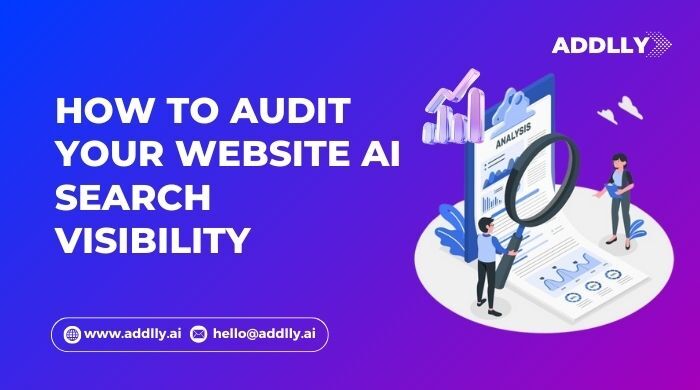Auditing your website AI search visibility requires a systematic evaluation of how well your content performs across AI-powered search platforms like ChatGPT, Perplexity, and Claude. This process identifies technical barriers, content gaps, and structural issues that prevent AI models from discovering, understanding, and citing your content in AI overviews and ai generated answers.
Unlike traditional search engines and search engine optimization (SEO) strategy audits that focus on keywords, backlinks, and search rankings, AI search visibility audits examine semantic structure, site structure, and machine-readable formatting that enables generative search engines to parse and reference your material. As Google AI Overviews, voice search, and generative AI tools increasingly influence consumer discovery in 2025, conducting regular AI search audits has become essential for maintaining online visibility, organic traffic, and long-term competitiveness.

Quick Summary – How to Audit Your Website AI Search Visibility?
This blog breaks down how to audit your website’s AI search visibility across platforms like ChatGPT, Perplexity, and Google AI Overviews. Key takeaways include:
- What AI search visibility means (and how it differs from traditional SEO).
- How to audit your website using Addlly AI’s GEO Audit Tool.
- How to identify technical and content gaps using structured audit methods.
- Tools and methods to uncover issues in schema, entity alignment, and semantic clarity.
- Actionable steps to fix crawlability, improve formatting, and align with AI comprehension models.
- Why consistent monitoring and automation are critical for sustainable GEO results.
If you want your content to appear in AI-generated answers, not just traditional SERPs, then regular audits are your first step toward long-term visibility.ents as both AI algorithms and traditional search engines continue evolving.
What Does an AI Search Algorithm Consider?
AI search visibility depends on content accessibility, semantic clarity, structured data implementation, and information completeness that enables AI models to confidently cite your content in generated responses. These factors differ significantly from traditional search results signals and require specific AI optimization approaches.
AI models prioritize content that provides clear, authoritative, and concise answers with verifiable information and proper context. They evaluate trustworthiness through entity relationships, citation-worthy formatting, and comprehensive topic coverage rather than traditional metrics like keyword density or backlink quantity.
Key Considerations Include:
- Content accessibility ensures AI crawlers can read your material without JavaScript barriers, mobile optimization issues, or slow page speed.
- Semantic structure helps AI models interpret context, understand search queries, and establish topical authority through clear headings and logical organization.
- Schema markup provides machine-readable context that improves AI comprehension and citation probability, often surfacing content in rich snippets and blue links.
- Information completeness offers accurate responses that AI models can confidently reference.
- Entity optimization establishes strong connections between your content and broader knowledge graphs, boosting site visibility and user engagement.
Understanding these factors enables targeted optimization that improves your content’s likelihood of appearing in AI-driven search results and conversational responses.
Read our guide on: How to Run a GEO Audit
Preparing the AI Search Visibility Pre-Audit Checklist
Conducting a comprehensive AI search readiness audit involves evaluating technical accessibility, content structure, and AI platform performance through systematic testing and analysis. This multi-step process identifies specific barriers preventing optimal visibility across different generative engine optimization (GEO) environments.
The audit process requires examining both technical implementation and content quality factors that influence AI citation decisions. This includes testing how your content appears when referenced by AI systems, checking for outdated content, and identifying gaps in discoverability or comprehension.
1. Fix Technical Barriers First
Before refining content, ensure your site can be properly crawled and indexed by AI search engines. Common blockers include crawlability issues, JavaScript rendering problems, or overly complex site structures. By simplifying your architecture and ensuring pages load correctly across devices, you make it easier for AI systems to parse and evaluate your content.
2. Strengthen Internal Linking and Semantic Structure
AI relies on context to understand relationships between topics. Internal links help establish that context by connecting related pages, signaling topic clusters, and guiding crawlers to important content. Pair this with strong semantic HTML – using clear headings, descriptive subheaders, and well-structured paragraphs – to increase the likelihood of being surfaced in AI-generated overviews.
3. Enhance Content Completeness and Depth
Shallow content struggles to compete in generative results. Expand existing pages to cover topics more comprehensively, anticipating the “next question” a reader might ask. Incorporate data, real-world examples, and step-by-step explanations to position your content as an authoritative source that AI is more likely to reference.
4. Deploy Schema Markup Strategically
Schema markup provides machine-readable context, which generative engines use to identify structured answers. Prioritize implementing schema types like FAQ, HowTo, and Organization, as these align directly with common AI-generated responses. When properly deployed, schema can increase visibility in rich results and AI-generated citations.
5. Optimize Entities and Align With Training Data
Generative search models draw on entity-based understanding. Make sure your content clearly defines, links to, and reinforces key entities relevant to your industry such as brands, products, locations, and recognized experts. This alignment with structured knowledge sources helps AI connect your content with authoritative datasets, boosting its credibility.
6. Monitor Performance Iteratively
Implementation doesn’t end with publishing. Track results using Google Search Console and Analytics to measure impressions, clicks, and engagement. Focus on whether updated content aligns with user intent and how it performs in AI-driven overviews. Continuous feedback loops allow you to refine strategies over time, ensuring improvements are sustainable.
Checkout our guide on: Best AI Visibility Optimization Tools
Automate and Scale With Addlly AI
Manual implementation can be resource-heavy. Addlly AI streamlines the process by automating schema deployment, optimizing entities, and applying structured improvements consistently across your site. This ensures your editorial voice remains intact while maintaining technical and semantic standards required for GEO success.
Addlly AI’s GEO Audit Tool specialized audit agents automate this complex process, providing comprehensive visibility assessments and prioritized recommendations without requiring technical expertise from marketing teams.
What Tools and Methods Identify AI Search Visibility Gaps?
Identifying AI search optimization gaps requires specialized tools that evaluate content through AI comprehension models rather than traditional metrics. These tools assess semantic structure, entity relationships, and citation-worthiness that influence AI-driven insights. Effective AI visibility assessment combines automated analysis with manual testing across multiple AI search platforms. This approach reveals both technical barriers and opportunities to improve site’s visibility in traditional Google searches and emerging AI-driven search results.
Key methods include:
- AI-powered content analysis tools to assess clarity, data-driven insights, and AI understand signals.
- Schema validation tools to catch markup errors affecting frequently referenced queries.
- Entity mapping to align content with knowledge graphs and improve search queries visibility.
- Technical crawling analysis to detect outdated content and accessibility barriers.
- Competitive visibility benchmarking to measure local SEO and global SEO strategy performance against competitors.
Addlly AI’s GEO audit agents integrate these methodologies into comprehensive assessments that deliver actionable insights for improving search console visibility across all relevant platforms and query types.
How Do You Implement Improvements Based on Audit Findings?
Implementing improvements requires prioritizing high-impact changes that enhance AI comprehension and citation probability. This systematic approach addresses technical fixes first, then focuses on content restructuring, schema deployment, and iterative optimization.
The implementation process should prioritize changes that provide the greatest online visibility improvement with available resources.
Typical steps include:
- Fixing crawlability issues, JavaScript rendering errors, and site architecture barriers.
- Improving internal linking, semantic structure, and information completeness.
- Adding schema markup for FAQ, HowTo, and Organization details.
- Strengthening entity optimization and aligning with training data.
- Tracking improvements in search console and Google Analytics to monitor user intent, user engagement, and organic traffic.
- Using audit tools for continuous monitoring and refinement.
Addlly AI streamlines this implementation process through automated optimization and schema deployment, ensuring consistent improvements across all content while maintaining editorial standards.
Establish Your AI Search Visibility Strategy Today
As AI search platforms continue gaining influence over consumer discovery decisions, conducting regular AI search audits has become essential for maintaining digital competitiveness. Companies that establish robust AI search optimization and monitoring processes today will be better positioned as traditional search results give way to generative AI-driven responses.
Schedule your comprehensive AI search audit with Addlly AI to identify optimization opportunities and develop a targeted strategy for improving performance across both traditional search and AI-driven search results.
FAQs – Audit Your Website AI Search Visibility
What Makes An AI Search Visibility Audit Different From A Traditional SEO Audit?
AI search visibility audits focus on semantic structure, machine-readable content, and citation-worthiness, whereas traditional SEO audits emphasize keywords, backlinks, and blue links.
How Can I Tell If AI Platforms Like ChatGPT Or Perplexity Are Referencing My Website?
Test search queries on these platforms and look for your content cited in AI overviews or featured snippets.
What Are The Most Common Technical Barriers That Limit AI Search Visibility?
JavaScript rendering, inaccessible site architecture, and missing schema markup are the most frequent issues.
How Does Addlly AI Help Improve My Website’s Visibility In AI-driven Search Engines?
Addlly AI automates technical audits, semantic analysis, and schema deployment, providing data-driven insights and actionable recommendations.
Should I Prioritize Fixing Technical Issues Or Optimizing Content Structure For Better AI Visibility?
Address technical accessibility barriers first, then focus on enhancing semantic structure and structured data.
How Do I Monitor Ongoing Improvements In AI Search Visibility After Making Changes?
Track performance through search console, Google Analytics, and monitor user intent, user engagement, and organic traffic.
Is Competitive Benchmarking Important For AI Search Visibility Audits?
Yes, comparing your AI visibility against competitors highlights opportunities to improve digital marketing performance and strengthen positioning.


